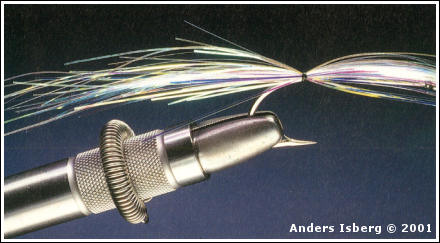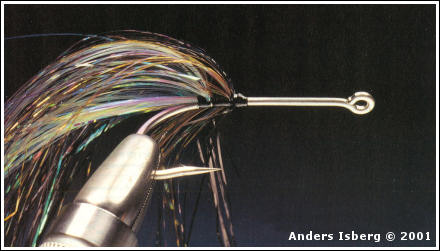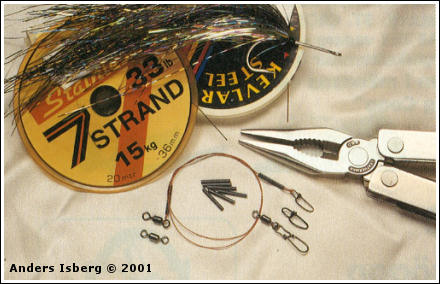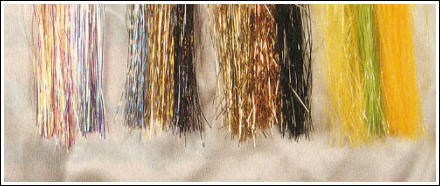|
Glitter for pike
By Anders Isberg
Pike bites not
only in fat wobblers. They are also interested in larger model
flies. Why not try a fly made of sparkly glitter instead for a
change and take your pike fishing to new heights.

Pikeflies of this
type is quite long. I have found a good fly box in a retired
aluminum lunch box with a piece of thick cut foam in the bottom.
Simple and stable
A
large, light and sparkly fly moves alluring in the water and is
a attractive bite for a hungry pike. With a 9-10 foot fly rod in
class 7-8 and a fast sinking WF line you can cast long distance
and reach great places from both land, from belly boats or
boats. Fished near and along a reed area, it is basically just a
matter of time before a pike takes you fly..
Flies with flash
materials have the advantage that they fish well even though
they are as large as 15 to 20 centimeters, the material does not
absorb water so that the fly is light when it is lifted from the
surface. All flash is tied in to a short lenght of the hook
shank above the barb, it prevent the wing to wrap itself around
the hook bend. Using the tying method presented in this article
also give the fly volume and some nice movement in the water. It
is easy to tie, holds quite well and can be varied in color and
size. All you then need to do is to find places where the pike
are.
Make it simple
The principle is very
simple. You tie on a bundle off flash approximately in the
middle of the hook and fold it back. Repeat a few times and
you're done. To get more style to give the wing more life I tie
on the wing in three stages. Each wing is tapered so that the
shortest flash fibres sits underneath and the longest on top.
You cut off a small stack of flash and form the fibre tips
uneven with your fingers, (see first tying step). Then I pull
excess part backwards, but without tying it down. The reason is
that the material then stands out better from the hook shank and
contributes to the volume and movement. I do the same with the
first two bundles. And I add each new bundle just in front of
the previous so that I get as much spread as possible. When the
third stack, which is the longest, ties on, I also tie down the
material which was folded backwards, to get a nice form to the
profile on the fly.
Taper the wing
By creating the fly so
that each bundle is tapered, and that each new stack is longer
than the previous, creates more movement to the tail end when
fished. The flash is cut to the full length (about 20 cm), the
first and possibly the second bundle can be shortened somewhat
before the fibres is pulled appart lenghtwise for creating
different length position from of each other (tapering).
But the last stack used
in full length. By the straw pulled unevenly and to fold back
the front part forward while tying the fly, you get almost no
waste of materials. You use almost all the cutoff material.
Flash material starts to cost a lot, but by tying this way you
utilized as much as possible of the material and it will be
quite many flies from some bundles of flash material and a
packet of hooks.

Check out the
feeding trap of this pike, number of teeth are about 700. Even a
thick nylon leader have no chance of holding in this environment
Flash and hooks
Flash come in all
varieties and colors. The fly in the picture is tied with a
first bundle of flash called Mirage, which is extremely shiny
and a little thicker which is great for creating volume.
The next batch is a mix
of Mirage and Rippleflash (Veniard) in gold and silver. The top
stack is a mixture of black holographic flash and plain black
flash from Flashabou. But the field is free for mixing colors of
all kind. Avoid flash materialof the type having small thin
threads spun around each flash fibre. After just a few casts and
some encounters with pike teeth these threads will losen from
the flash fibres and the fly instead becomes stiff and bushy.
I usually choose a
single hook with a straight eye in size 2/0-3/0 in stainless
steel from Partridge "Sea Prince", or Tiemcos saltwater hook 811
S. They have a “nice” weight that help casting and how the fly's
moves in the water. A whetstone may be good to bring if you need
to sharpen the hook.
Choose the correct
leader
Modern pike leaders have
the nylon softness and steel leader toughness. Often it is
kevlar like, soft and relatively expensive material that is
meant to cope with the pike sharp teeth. I for my part concluded
that making ordinary pike leaders in 30 lbs class, but with a
little more slender connecors, will give a very smooth
combination with relatively thin and light tippet that always
has the same length, and makes it easy to change the fly. The
tackle shop sells different kinds of steel leaders, with or
without kevlar, connectors, locking device, making it easy to
design a leader that you are happy with. These leaders are
cheap, easy to make and lasts a long time.
The Nylon leader between
the fly line and steel leader should be a bit thicker and not
too long. A leader consisting of equal parts of 0.60 mm, 0.50 mm
and 0.40 mm for a total length of about two meters are easy
controlled in the air and works well. And the end should be a
steel leader at around 0,3 meters. The connector allows the fly
move a bit better in the water.
Allow yourself to
fish by boat
Fishing is then done at
the usual pike areas from shore and boat. Do not forget the
belly boat fishing. It's fun, but paddle for safety's sake
always with companion if you'd put the big hook in the ring and
get a flat. Fly from a boat is probably really the most easiest
option because it takes less time to get away if the wind
increase and it gives more opportunities to switch places. In
addition, and one casts higher in the air which makes it easier
to cast farther and more accurately.

1. Make a bed of tying thread
of about 1 cm above the hook barb. Cut off a stack of 20 cm
flash, shorten it by 5 cm and fold it in half. Cut the loop
formed so that you now have a half as long bundle with twice as
many fibers. Then, pull the ends of the fibers so that they are
of different lengths. Let differ about 3-4 cm between the
shortest and longest fiber. Tie the whole stack on top of the
hook shank and inline of the barb with about 10 hard waxed
thread turns, so that the middle of the stack is offset against
the hook eye by about 1-2 cm. Fold back all flash straws that
points to the hook eye and bring the thread just in front of
these straws. But do not tie them down. Let the fibres point in
in all directions.

2. Now take a little thicker
bundle of flash, but do not shorten it, but pull the ends and
tie it in the same way, on top of the hook shank, and above the
previous stack. Fold backwards all straws that pointing to the
hook eye, but do not tie them down.

3. Take a third bundle of
flash, do not shorten it, do the same as with the previous
stack, but with the difference that now you fold it back and tie
it down on top, at the same tying spot. Tie the braided
flashtinsel with glued eyes if you want it. Forming a even head
and put on laquer.

4. Varnish underneath the
therad turns you can access. It increases the fly's durability.
Note that by using of a very short length of the hook shank
where you tie on the flash, this will also increases the fly's
durability.

5. Saltwater resistant single
hook in size 2/0-3/0. The biggest available eyes for flies glued
to 3 strips of braided holographic tinsel with super glue. Use
hackle plier to hold the strips in place until the glue sets.

6. One should use a real steel
leader for a Pikefly. I have certainly caught pike weighing over
4 kilos on tippets of 0.40mm, but lost many when I not used
steel leader. It is also more responsible towards the pike using
strong leader. I use the equivalent of 30-pound steel wire, with
or without kevlar lining and swivel at one end and only hook or
swivel and hook the other end.

From the left:
Mirage, Rippleflash (silver and gold) and Flashabou holographic
black Flashabou Original, Flashabou fluorescent and luminescent.
7. Flash comes in all
varieties. I use the most common type that is about 1mm wide.
Holographic flash and Mirage Flash is thicker than Flashabou
original, which itself is very soft. The Flash should be
slippery and shiny, then it works fine. I mix Flashabou original
with holographic flash, Veniard's rippleflash and Mirage Flash.
It provides the fly with real shining reflex. It is my opinioon
that the fly should be seen clearly and fished home at a good
speed, the fly should shine and pulsate.

8. The pike leader should be
long. One reason is that a Pikefly is light, and can go far into
the mouth of the pike when it bites over the fly. On this fly, a
pike that had the hook 25 cm into the mouth, was caught. But the
leader was longer.
By Anders Isberg
© 2001
Editors note:
Article translated from Swedish using Google translate service
so you have to excuse for incorrect grammar. Feel free to inform
us if you find any errors in
grammar.
|